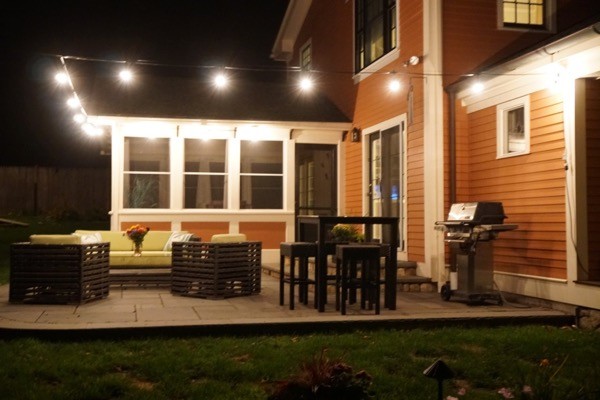String lights are a fantastic way to add ambiance and charm to your outdoor spaces, transforming patios, gardens, and decks into inviting havens. However, hanging them can be challenging without existing structures like trees or sturdy walls. This guide provides a step-by-step solution on how to attach string lights to a guide wire, creating a freestanding and aesthetically pleasing lighting display.
Illuminating your outdoor living area with string lights is easier than you might think. By using a guide wire, you can create the perfect ambiance, even without readily available support structures.
Planning Your String Light Design and Power Source
Before you begin the installation process, careful planning is crucial. Consider these key aspects to ensure a successful and safe setup:
- Desired Coverage: Determine the area you want to illuminate and visualize the desired arrangement of your string lights. Measure the distance to calculate the required wire and string light length.
- Power Source: Identify the closest outdoor electrical outlet. If one doesn’t exist, consider installing a weatherproof outlet or using a heavy-duty outdoor extension cord. Ensure the cord is rated for outdoor use and can handle the wattage of your string lights.
- String Light Type: Choose string lights that are suitable for outdoor use. LED string lights are energy-efficient and long-lasting. Consider the bulb spacing and the overall length of the string to match your design plan.
- Support Structure Assessment: Evaluate your surrounding structures – house walls, fences, or even sturdy posts. Determine the best points to anchor your guide wire, keeping in mind the overall aesthetic and the structural integrity of your chosen anchor points.
Essential Tools and Materials
To successfully attach your string lights to a guide wire, you’ll need the following tools and materials:
- Guide Wire (Galvanized or Stainless Steel): Choose a durable, weather-resistant cable strong enough to support the weight of your string lights. A 1/16-inch diameter cable with a working load limit of 100 lbs is generally sufficient.
- String Lights: Select outdoor-rated string lights. Consider LED options for energy efficiency.
- Turnbuckles: These are used to tighten the guide wire and prevent sagging. You’ll need two turnbuckles.
- Eye Bolts or Hooks: These will be used to attach the guide wire to your support structures. Choose hooks or eye bolts appropriate for the material you’re attaching to (wood, brick, etc.).
- Wire Rope Clips (Cable Clamps): These are used to secure the guide wire to the turnbuckles and eye bolts.
- Zip Ties (Cable Ties): These will be used to attach the string lights to the guide wire. Choose UV-resistant zip ties for outdoor use.
- Drill: For pre-drilling pilot holes when installing eye bolts or hooks.
- Wrench: To tighten the turnbuckles.
- Wire Cutters: To cut the guide wire to the desired length.
- Measuring Tape: For accurate measurements.
- Safety Glasses and Gloves: For personal protection.
- Optional: Rubber hose (for protecting tree branches if using them as anchor points), carabiners.
Step-by-Step Guide: Attaching String Lights to Guide Wire
Follow these steps to create a stunning and durable string light display:
-
Install Anchor Points: Determine the location of your anchor points on walls, posts, or other sturdy structures. Drill pilot holes and install eye bolts or hooks securely. Ensure they are firmly anchored to support the weight of the wire and lights. For added safety, install into solid framing, locating rafter tails for example.
-
Attach Guide Wire to Anchor Points: Measure and cut the guide wire to the appropriate length, leaving extra length for looping around the turnbuckles and eye bolts. Attach one end of the guide wire to an eye bolt using a wire rope clip. Loop the wire around the eye bolt and secure it back onto itself with the clip.
-
Install Turnbuckles: Attach a turnbuckle to the opposite eye bolt. Connect the guide wire to the turnbuckle using a wire rope clip, similar to how you attached it to the eye bolt.
-
Tension the Guide Wire: Tighten the turnbuckles to create tension in the guide wire. This will prevent sagging and ensure your string lights hang properly. Avoid overtightening, which could damage the anchor points or the wire itself.
-
Attach String Lights to Guide Wire: Starting at one end, use zip ties to attach the string lights to the guide wire. Space the zip ties evenly along the wire to distribute the weight of the lights. Ensure the power plug is located near your outlet.
-
Fine-tune and Secure: Once all the lights are attached, double-check the tension of the guide wire and adjust the turnbuckles if needed. Trim any excess zip tie length for a cleaner look.
Important Considerations and Tips
-
Tree Protection: If using a tree branch as an anchor point, protect the branch by wrapping it with a rubber hose before attaching the guide wire. However, avoid attaching the cable directly around the tree trunk as it will cause damage as the tree grows.
-
Sag Prevention: To minimize sagging, especially over long spans, consider using a thicker gauge guide wire or adding additional support points.
-
Even Weight Distribution: Ensure the weight of the string lights is evenly distributed along the guide wire to prevent stress on any single point.
-
Weather Resistance: Choose materials and components that are specifically designed for outdoor use to withstand the elements.
-
Safety First: Always disconnect power before working with electrical components and follow all safety precautions.
Enjoy Your Illuminated Outdoor Space!
By following these steps, you can successfully attach string lights to a guide wire, creating a magical and inviting outdoor space for relaxation and entertainment. With careful planning and the right tools, you can transform any area into a beautifully lit oasis.
